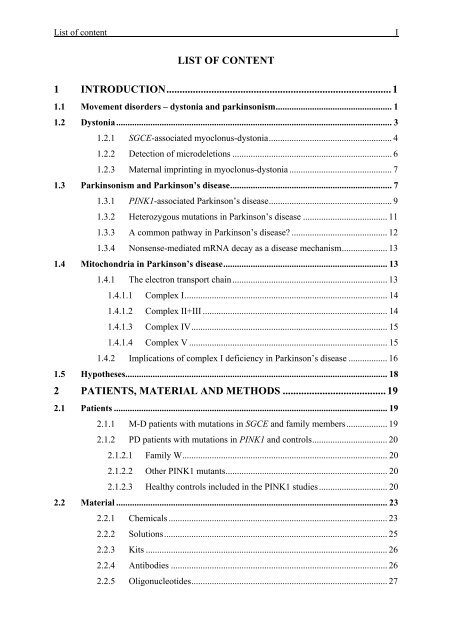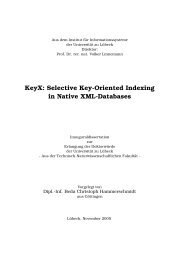Molecular characterisation of SGCE-associated myoclonus-dystonia ...
Molecular characterisation of SGCE-associated myoclonus-dystonia ...
Molecular characterisation of SGCE-associated myoclonus-dystonia ...
You also want an ePaper? Increase the reach of your titles
YUMPU automatically turns print PDFs into web optimized ePapers that Google loves.
List <strong>of</strong> content<br />
I<br />
LIST OF CONTENT<br />
1 INTRODUCTION..................................................................................... 1<br />
1.1 Movement disorders – <strong>dystonia</strong> and parkinsonism................................................... 1<br />
1.2 Dystonia......................................................................................................................... 3<br />
1.2.1 <strong>SGCE</strong>-<strong>associated</strong> <strong>myoclonus</strong>-<strong>dystonia</strong>...................................................... 4<br />
1.2.2 Detection <strong>of</strong> microdeletions ...................................................................... 6<br />
1.2.3 Maternal imprinting in <strong>myoclonus</strong>-<strong>dystonia</strong> ............................................. 7<br />
1.3 Parkinsonism and Parkinson’s disease....................................................................... 7<br />
1.3.1 PINK1-<strong>associated</strong> Parkinson’s disease...................................................... 9<br />
1.3.2 Heterozygous mutations in Parkinson’s disease ..................................... 11<br />
1.3.3 A common pathway in Parkinson’s disease? .......................................... 12<br />
1.3.4 Nonsense-mediated mRNA decay as a disease mechanism.................... 13<br />
1.4 Mitochondria in Parkinson’s disease........................................................................ 13<br />
1.4.1 The electron transport chain.................................................................... 13<br />
1.4.1.1 Complex I......................................................................................... 14<br />
1.4.1.2 Complex II+III ................................................................................. 14<br />
1.4.1.3 Complex IV...................................................................................... 15<br />
1.4.1.4 Complex V ....................................................................................... 15<br />
1.4.2 Implications <strong>of</strong> complex I deficiency in Parkinson’s disease ................. 16<br />
1.5 Hypotheses................................................................................................................... 18<br />
2 PATIENTS, MATERIAL AND METHODS ....................................... 19<br />
2.1 Patients ........................................................................................................................ 19<br />
2.1.1 M-D patients with mutations in <strong>SGCE</strong> and family members.................. 19<br />
2.1.2 PD patients with mutations in PINK1 and controls................................. 20<br />
2.1.2.1 Family W.......................................................................................... 20<br />
2.1.2.2 Other PINK1 mutants....................................................................... 20<br />
2.1.2.3 Healthy controls included in the PINK1 studies.............................. 20<br />
2.2 Material ....................................................................................................................... 23<br />
2.2.1 Chemicals ................................................................................................ 23<br />
2.2.2 Solutions.................................................................................................. 25<br />
2.2.3 Kits .......................................................................................................... 26<br />
2.2.4 Antibodies ............................................................................................... 26<br />
2.2.5 Oligonucleotides...................................................................................... 27

















